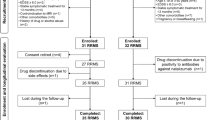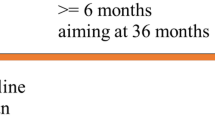Abstract
No evidence of disease activity-3 (NEDA-3), defined as absence of clinical relapse, disability progression, and brain magnetic resonance imaging (MRI) activity, has emerged as the therapeutic target of disease-modifying therapy for multiple sclerosis (MS). However, recent studies have revealed that NEDA-3 might not be sufficient to prevent cognitive deterioration and predict long-term disability. In addition to NEDA-3, brain atrophy has recently been recognized as a pivotal biomarker that is closely associated to disability in patients with MS. This retrospective observational study included 22 Japanese MS patients with relatively mild disease (median expanded disability status scale = 1.75). Fifteen patients (68%) received disease-modifying therapy (DMT), including interferon (IFN)-β (n = 6), IFN-β, or azathioprine followed by fingolimod (n = 4), fingolimod (n = 4), and IFN-β followed by natalizumab (n = 1). It revealed that 14 (64.6%) patients achieved NEDA-3 in the 2-year observational period. However, nine (64.3%) of the patients with NEDA-3 were revealed to have a significant BVL, defined as ≥ 0.4% per year. Importantly, these nine patients included all patients receiving IFN-β therapy (n = 6), whereas patients without BVL included none of these patients. Conversely, patients treated with fingolimod following IFN-β did not have significant BVL. These results indicate that evaluation of NEDA-4 is encouraged especially in patients with IFN-β therapy in MS clinical practice in Japan although Japanese MS patients have generally been thought to possess a milder disease including brain atrophy compared to their Western counterparts.
Similar content being viewed by others
References
Geurts JJG, Calabrese M, Fisher E, et al (2012) Measurement and clinical effect of grey matter pathology in multiple sclerosis. Lancet Neurol 11:1082–1092
De Stefano N, Giorgio A, Battaglini M et al (2010) Assessing brain atrophy rates in a large population of untreated multiple sclerosis subtypes. Neurology 74:1868–1876
Fisher E, Rudick RA, Simon JH, et al (2002) Eight-year follow-up study of brain atrophy in patients with MS. Neurology 59:1412–1420
Jacobsen C, Hagemeier J (2014) Brain atrophy and disability progression in multiple sclerosis patients: a 10-year follow-up study. J Neurol Neurosurg Psychiatry 85:1109–1115
Radue E-W, Barkhof F, Kappos L, et al (2015) Correlation between brain volume loss and clinical and MRI outcomes in multiple sclerosis. Neurology 84:784–793
Kappos L, De Stefano N, Freedman MS, et al (2016) Inclusion of brain volume loss in a revised measure of “ no evidence of disease activity ” ( NEDA-4 ) in relapsing – remitting multiple sclerosis. Mult Scler 22:1297–1305
Nemoto K, Dan I, Rorden C, et al (2011) Lin4Neuro: a customized Linux distribution ready for neuroimaging analysis. BMC Med Imaging 11:3
De Stefano N, Stromillo ML, Giorgio A, et al (2016) Establishing pathological cut-offs of brain atrophy rates in multiple sclerosis. J Neurol Neurosurg Psychiatry 87:93–99
Rocca MA, Amato MP, De SN et al (2016) Clinical and imaging assessment of cognitive dysfunction in multiple sclerosis. Lancet Neurol 14:302–317
Rotstein DL, Healy BC, Malik MT, et al (2015) Evaluation of no evidence of disease activity in a 7-year longitudinal multiple sclerosis cohort. JAMA Neurol 72:152–158
De SN, Stromillo ML, Giorgio A et al (2015) Long-term assessment of no evidence of disease activity in relapsing-remitting MS. Neurolgy 85:1722–1723
Prosperini L, Fanelli F, Pozzilli C et al (2016) Long-term assessment of no evidence of disease activity with natalizumab in relapsing multiple sclerosis. J Neurol Sci 364:145–147
Cree BAC, Gourraud PA, Oksenberg JR et al (2016) Long-term evolution of multiple sclerosis disability in the treatment era. Ann Neurol 80:499–510
Damasceno A, Damasceno BP, Cendes F (2016) No evidence of disease activity in multiple sclerosis: implications on cognition and brain atrophy. Mult Scler 22:64–72
Tanaka M, Matsui M, Tahara M, et al (2011) Low incidence of asymptomatic contrast-enhancing brain lesions in Japanese patients with multiple sclerosis. Eur Neurol 65:119–122
Hardmeier M, Wagenpfeil S, Freitag P, et al, for the European IFN-1a in Relapsing MS Dose Comparison Trial Study Group (2005) Rate of brain atrophy in relapsing MS decreases during treatment with IFN-1a. Neurology 64:236–240
Piccolo L, Kumar G, Nakashima I, et al (2015) Multiple sclerosis in Japan appears to be a milder disease compared to the UK. J Neurol 262:831–836
Akaishi T, Nakashima I, Mugikura S, et al (2017) Whole brain and grey matter volume of Japanese patients with multiple sclerosis. J Neuroimmunol 306:68–75
Author information
Authors and Affiliations
Corresponding author
Ethics declarations
All procedures performed in studies involving human participants were in accordance with the ethical standards of the institutional and/or national research committee and with the 1964 Helsinki declaration and its later amendments or comparable ethical standards. For this type of study, formal consent is not required.
Conflict of interest
The authors declare that they have no conflict of interest.
Rights and permissions
About this article
Cite this article
Yokote, H., Kamata, T., Toru, S. et al. Brain volume loss is present in Japanese multiple sclerosis patients with no evidence of disease activity. Neurol Sci 39, 1713–1716 (2018). https://doi.org/10.1007/s10072-018-3487-y
Received:
Accepted:
Published:
Issue Date:
DOI: https://doi.org/10.1007/s10072-018-3487-y




